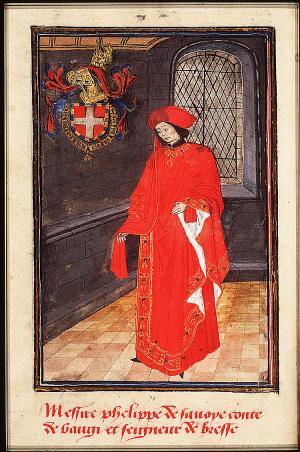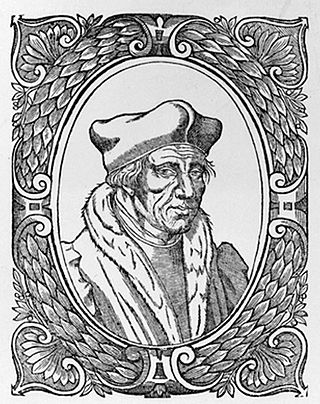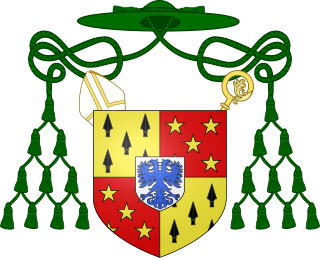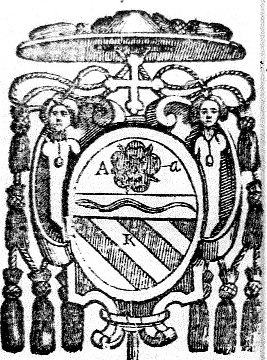This article needs additional citations for verification .(March 2017) |

Jean Simon de Champigny (died 1502) was a French prelate who was Bishop of Paris from 1492 to 1502.
This article needs additional citations for verification .(March 2017) |

Jean Simon de Champigny (died 1502) was a French prelate who was Bishop of Paris from 1492 to 1502.
Jean Simon de Champigny was the son of Jean Simon, Seigneur of Champigny-sur-Marne and Combeaux (probably modern-day Pontault-Combault), who had served in the Parlement of Paris, and Jeanne Chambon. His sister Marie was the mother of Antoine Sanguin, and grandmother of Anne de Pisseleu d'Heilly. [1] After inheriting his father's seigneury, he repaired the family's castle in 1490.
Jean Simon de Champigny entered the service of Charles VIII of France, becoming a councilor in the Parlement of Paris, canon of Notre Dame de Paris, and Archdeacon of Soissons.
In 1492, Champigny was unanimously elected Bishop of Paris. Pope Alexander VI confirmed his appointment on 29 October 1492; Champigny took the oath of allegiance on 10 December 1492; and in 1494, he traveled to Sens, where he was consecrated by Tristan de Salazar, Archbishop of Sens, on 22 September 1494. Champigny made his solemn entry into Paris in February 1495.
As bishop, he held a synod on 7 May 1495. He also gifted a chapel to the Collège de Montaigu. He also helped to establish or reform several religious orders.
Champigny died of plague on 23 December 1502.

Philip II, surnamed the Landless, was the Duke of Savoy for a brief reign from 1496 to 1497.

Charles VIII, called the Affable, was King of France from 1483 to his death in 1498. He succeeded his father Louis XI at the age of 13. His elder sister Anne acted as regent jointly with her husband Peter II, Duke of Bourbon until 1491, when the young king turned 21 years of age. During Anne's regency, the great lords rebelled against royal centralisation efforts in a conflict known as the Mad War (1485–1488), which resulted in a victory for the royal government.

Étienne Charles de Loménie de Brienne was a French clergyman, bishop, cardinal, politician and finance minister of King Louis XVI.

Jacques Lefèvre d'Étaples was a French theologian and a leading figure in French humanism. He was a precursor of the Protestant movement in France. The "d'Étaples" was not part of his name as such, but used to distinguish him from Jacques Lefèvre of Deventer, a less significant contemporary who was a friend and correspondent of Erasmus. Both are also sometimes called by the German version of their name, Jacob/Jakob Faber. He himself had a sometimes tense relationship with Erasmus, whose work on biblical translation and in theology closely paralleled his own.
Johann Burchard, also spelled Johannes Burchart or Burkhart (c.1450–1506) was an Alsatian-born priest and chronicler during the Italian Renaissance. He spent his entire career at the papal Courts of Sixtus IV, Innocent VIII, Alexander VI, Pius III, and Julius II, serving as papal Master of Ceremonies, a position from which he was able to observe most of the important events of the period.

The Archdiocese of Paris is a Latin Church ecclesiastical jurisdiction or archdiocese of the Catholic Church in France. It is one of twenty-three archdioceses in France. The original diocese is traditionally thought to have been created in the 3rd century by St. Denis and corresponded with the Civitas Parisiorum; it was elevated to an archdiocese on October 20, 1622. Before that date the bishops were suffragan to the archbishops of Sens.

Ascanio Maria Sforza Visconti was an Italian cardinal of the Catholic Church. Generally known as a skilled diplomat who played a major role in the election of Rodrigo Borgia as Pope Alexander VI, Sforza served as Vice-Chancellor of the Holy Roman Church from 1492 until 1505.
The decade of the 1490s in art involved some significant events.

The Diocese of Luçon is a Latin Church diocese of the Catholic Church in France. Its see is Luçon Cathedral in the commune of Luçon. The diocese comprises the department of Vendée. Created in 1317 out of the diocese of Poitiers, its existence was interrupted during the French Revolution, but it was restored in 1821, along with the Bourbon restoration.
Hieronymus Münzer or Monetarius was a Renaissance humanist, physician and geographer who made a famous grand tour of the Iberian Peninsula in 1494–95. He was co-author of the Nuremberg Chronicle.

Juan de Borja Lanzol (Llançol) de Romaní, el mayor was the first of ten cardinal-nephews elevated by Pope Alexander VI, the cousin of his father, Galcerán de Borja y Moncada.

Guido de Monte Rochen or Guy de Montrocher was a French priest and jurist who was active around 1331. He is best known as the author of Manipulus curatorum, a handbook for parish priests, that was often copied, with some 180 complete or partial manuscripts surviving, and later reprinted throughout Europe in the next 200 years, with at least 119 printings, and sales which have been estimated to be three times those of Thomas Aquinas' Summa Theologica. It became obsolete only when the Council of Trent created the Roman Catechism in 1566.

Étienne Tristan de Salazar was the Archbishop of Sens from 1475 to 1518.

Giambattista Orsini was an Italian Roman Catholic cardinal. He served as papal legate to the Marches of Ancona.
André d'Espinay was a French Roman Catholic bishop and cardinal.

Jean Bilhères de Lagraulas or Jean Villier de la Grolaie, or Groslaye etc., also called the Cardinal of Saint-Denis, was a French Roman Catholic abbot, bishop and from 1493 cardinal. He died as French ambassador in Rome, and is remembered for commissioning Michelangelo in 1498 to sculpt his Pietà for St. Peter's Basilica.

Michel Riccio (1445–1515) was an Italian-born French lawyer, public official and historian. He was known in Italian also as Michele Riccio / Rizzo or Ricci, in Latin Michael Ritius, and in the French form Michel de Ris or de Rys.
Gérard Gobaille was a French bishop.
Events from the year 1502 in France